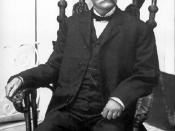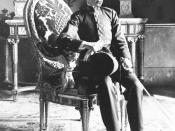The makeup of Cuba in the late nineteenth century is much the same as it is today. Nearly 66% of the population are white and of Spanish descent. About 22% are of mixed racial heritage, and 12% of the populace is black. Cuba lies to the south of the United States, and is most easily accessible by boat from the Florida region. It is this naval quality that encompasses the island.
During the Ten Years War, between 1868-1878, the Cubans fought against Spanish rule in their country. Rebellion broke out around the island, and the rebels joined under a united leader, Carlos de Cespedes, a wealthy planter, who proclaimed independence from Spain. Nearly 200,000 lives were lost, until the Treaty of El Zanjun was signed. This agreement promised the government would reform and abolish slavery and the tyrannical rule it held over the Cubans. The treaty was not honored however, and resistance was again put up in 1885.
The Spanish king at the time Alfonso XIII, encouraged the use of concentration camps for revolutionaries caught in battle. The Cuban Revolution became extremely bloody due to the use of Guerrilla warfare. This military operation, conducted on its home terrain, consisted of inhabitants fed up with oppressive rule. The men involved operated from bases located deep in the jungle, dense forests, and high rocky elevations. Guerrillas depended on natives for food, shelter, and useful information. While striking swiftly was a must, the bands of men were specialized in the undetected raiding of enemy camps. They could ambush a patrol, kill the soldiers, and supply their entire company in a matter of hours. Cutting communication between enemy lines became a prime target, once severed from the army, a battalion could be attacked, disarmed, and their reserves used for the revolutionaries.
It was...


